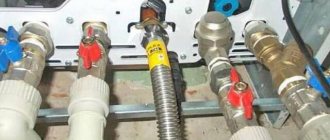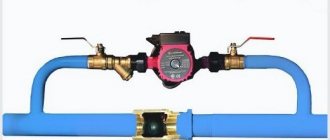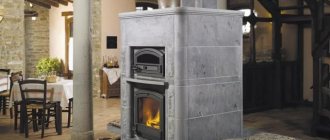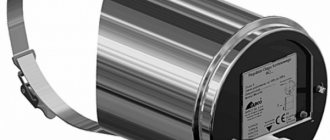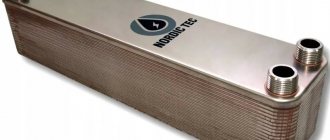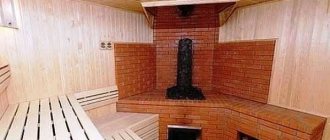Hot water is required for the sauna to function. The heat exchanger for a sauna stove provides comfort thanks to the ability to heat the liquid in the storage tank. You can spray the heater and take a shower without buying a boiler. The main thing is to find a high-quality heat exchanger for a wood-burning stove so that the performance of the device after its placement meets the needs of users. You can comply with sanitary requirements and enjoy the steam room without fear for the safety of people. Installing a heat exchanger will not take much time when choosing the optimal location for the structure.
What it is
A heat exchanger for a bath is a device that transfers heat coming from hot water up the pipe. The operation of the structure is based on the properties of the liquid. When heated, the hot water in the bath moves through a heat exchanger through a pipe into a tank located in the steam room. Cool liquid enters for heating, replacing the vacated space below. The heat exchanger in a furnace is often small. This allows the liquid to heat up at high speed. Two sections of pipeline are located at the bottom and top of the device.
The heat exchanger for the stove is located in the steam room; there are ways to place the washing compartment. Water flows independently along the lower pipe and provides operating temperature for washing when leaving. A heat exchanger for a sauna stove can be purchased inexpensively by installing the structure into the stove. The absence of adjacent devices will not disrupt the overall style of the room. A heat exchanger installed on the chimney pipe into the bathhouse significantly saves space. Methods for heating water in a bath from a stove
The heat exchanger for a bathhouse stove can be installed anywhere, at the owner’s discretion, if the model is chosen correctly. The device provides different methods of heating water:
- The “samovar” type model is located on the chimney. Warm smoke passes through the pipe, heating the water. The tap is attached to a reservoir containing warm liquid. The heating option is suitable for the compartment in the bathhouse where the shower is located.
- The stove with a heat exchanger for a samovar-type bath is small and allows the location of the tank in the washing compartment. The device heats the water.
- The heat exchanger for the bathhouse is located on the chimney.
- A reservoir plus a chimney involves heat transfer, in which internal energy is moved by water flows. Heat exchangers for stoves without controlled heat exchange are installed in the steam room. Heating is carried out in contact with the wall of the chimney pipe. The model is not protected from heat, which can lead to boiling of the liquid in the tank.
Chimney - a convector with a built-in heater is mounted in the stove and is also located near the chimney. The tank is connected by pipes with a register for the sauna stove inside the pipeline.
It is necessary to buy a heat exchanger for a heating furnace based on the choice of a specific model with special technical characteristics. Choose a design that is located inside the stove for engineering reasons. It has only one drawback - scale accumulation. Near the chimney, the water heats up slowly, but the high efficiency and the existing possibility of quick repairs can be arguments for deciding to purchase the device.
Built-in or homemade design
Some stoves are sold with already built-in heat exchangers. This is a convenient and compact option that is quite easy to install in the bathhouse. But it is designed only for small rooms: steam room and wash room.
Features of the built-in heat exchanger:
- The water tank is pre-integrated into the combustion chamber;
- Heat loss is minimal, and water heating is at a high speed;
- The capacity has limited volumes;
- In the built-in heat exchanger, due to the high temperature of the water, additional, increased pressure arises, which forces water to circulate throughout the entire circuit;
- In any case, installation of additional pipes is required.
Built-in tanks and pipes are usually made of different metal alloys. They have a pre-limited design. However, they can always be supplemented with an external heat exchanger or boiler.
An external heat exchanger can complement the internal one or be welded to a stove that is not equipped with such devices.
Features of external heat exchanger:
- Can have any volume;
- May have an additional boiler;
- Poorly suited for heating the entire room circuit;
- Heated by a stove or chimney, or has a combined heating method;
- The coolant is more designed to generate hot water for washing;
- It has a more complex design and requires the installation of additional pipes, elbows and taps.
It is ideal to combine the built-in and additional heat exchanger with external equipment. But this option will be the most expensive and time-consuming.
Difference by type
A stove coil with a couple of holes is a simple heat exchanger for a wood stove. It uses heated water to exit through a hole at the top.
The heat exchanger for a sauna stove is installed on the chimney using two cylindrical and rectangular containers. The connecting pipeline provides good fluid throughput. Installing a heat exchanger on a sauna stove requires an anti-corrosion coating to protect the metal.
The classification of units has a variety of subtypes that involve changes in structures or components, individual elements, and materials. You can buy a heat exchanger for a bath in two types: according to the location of the tank and according to the location. The second option suggests two possibilities: in the stove or near the chimney.
The bath tank with a heat exchanger, built into the stove, heats up quickly, but there is a possibility of the liquid boiling. Replacement if damaged will be possible only after dismantling the brickwork of the furnace. The accumulation of scale is accompanied by a decrease in efficiency due to a decrease in heat transfer.
A heat exchanger for a chimney pipe into a bathhouse does not create a similar problem, since slight heating does not lead to boiling.
Installing a heat exchanger in a bathhouse under stones is not rational for those who like to take a steam bath. The temperature of the steam room will be insufficient with this arrangement of the structure.
At the location of the water tank
A sauna tank with a heat exchanger can be placed in any standard sauna compartment, be it a steam room or a washing room. The first option simplifies installation due to a small pipeline, which increases the speed of water heating. Buying a heat exchanger for a sauna stove is necessary for optimal arrangement near the chimney. The enlarged pipeline will not allow the installation of a stationary shower. The problem is resolved with the help of a flexible hose located no higher than 1.5 meters for the required liquid supply pressure.
The next option involves placing the tank in the attic of the bathhouse. But the location will require additional insulation of the device. In addition, to top up the container with liquid you will have to carry buckets or connect the water supply.
The question of how to connect the tank to the heat exchanger of a sauna stove is decided taking into account the personal preferences of the owners, based on the prepared project.
Priority for installing a heat exchanger in a steam room
The heat exchanger in the furnace is mounted on the bottom. Like a water jacket, the fuel chamber houses the structure on the inside. Some builders prefer to place the heat exchanger for a sauna stove with their own hands on the outer wall. Both devices do not allow direct contact with fire. The popularity of the internal placement method is based on a number of advantages:
- The compact device does not take up much space in the steam room.
- The water heats up quickly.
- Can be installed in a steam room or shower.
- Design safety.
Installing a heat exchanger on the inside isolates the hot tank from external influences. People do not have to worry about accidental contact with the heated surface of the container. In addition, the placement significantly saves space in the steam room.
The furnace coil, installed on the outer wall, functions as an additional source of heating for the room. The main purpose of the design is related to the problem of how to connect the heat exchanger to the sauna tank. A stainless steel pipeline about 7 meters long is connected in different ways: using a tee, fitting, connecting tube, drain valve and other components of the system. Differences in installation and operation of the heat exchanger
The heat exchanger in the bath is located between the firebox and the heating device in the following ways:
- built into the stove;
- attached to the chimney;
- located near the chimney.
The main condition for the system to work is an uninterrupted supply of water to fill the tank. Many people use a circular pump for this. Hot water in the bathhouse fills a 120-liter tank through a heat exchanger, which is enough to take a shower. A heat exchanger for a bath with your own hands must take into account the installation features:
- The total pipeline distance is no more than 3 meters. This reduces heat loss.
- The device for moving water under pressure is not used when using a pipe with a radius of 0.5 inches;
- Repeated use of methods for heating water in a bathhouse justifies the efficiency of the system.
The operating principle of the heat exchanger is based on the flow of liquid into the pipeline from a third-party reservoir. As a rule, a small pressure of liquid from the tank is enough for gravity flow. A copper or steel pipeline is placed in the stove in the form of a coil or several registers, in the shape of a spiral. Its length is about 7 meters. The degree of water heating is regulated by two taps located at the inlet and outlet.
The heat exchanger on the pipe in the bathhouse efficiently heats the water at any time of the year. Inside the stove, the device can heat the premises of a country house and be a source of warm water in everyday life. If you increase the size of the firebox and use heat-resistant materials, then the stove with a heat exchanger for the bath becomes part of the home heating system.
Principle of operation
According to the principle of operation, water heating devices are divided into 3 types:
- a coil built into the heater;
- an external heat exchanger in the bathhouse in the form of a rectangular tank, heated directly from the furnace wall;
- external water circuit that removes heat from flue gases.
In the first case, the heat exchanger is a coil made of a steel pipe, built directly into the firebox. It is positioned in such a way that the pipe is not exposed to direct flame, that is, it is outside the highest temperature zone. It is desirable that the element stands in the way of waste products of fuel combustion, then it will not burn out and will last long enough. The built-in coil for heating the water at the outlet has connections for connecting pipes leading to a remote storage tank.
In such heat exchangers, the water warms up quite quickly, but the process cannot be called effective. After all, the heater takes heat directly from the firebox, thereby reducing the heater power. The steam room takes longer to warm up, which means more wood is consumed. Hot flue gases flew out into the chimney and continue to fly out unhindered; the efficiency of the unit remains very low (no more than 50%).
An external hanging tank made of stainless steel is another option for transferring furnace heat to water. Usually it is suspended from one of the side walls of the firebox and heated by infrared radiation from it. The method is attractive due to its ease of implementation, but is not very convenient to use. In addition to the disadvantage of direct heat extraction described above, the hanging tank also requires constant addition of cold water.
Rules for installing a heat exchanger on a sauna stove
Connecting a heat exchanger in a bath offers several installation options, depending on the location of the device. The following rules apply during installation:
- The stove operates with a good efficiency factor if the heat exchanger for the stove burns no more than 15 percent of the energy.
- Water flows by gravity through the pipes if the slope during direct supply is 250 degrees, and when returning - 30 degrees.
- The installation of the structure provides for a power reserve necessary for cooling after the combustion of wood.
- It is necessary to maintain the required amount of liquid in the tank at all times. If there is not enough water, then boiling contributes to the formation of scale. Large quantities take a long time to heat up.
The connection of the tank to the heat exchanger in the bath occurs in compliance with the requirements:
- The inlet to the tank is located above the short-length upper pipe, which is used to connect equipment. This ensures good water circulation.
- The upper register is placed 1.5 meters above the floor. The bottom of the container in the steam room is located above 1.5 meters. The parameters are indicated with a stove stand no higher than 15cm.
- If there is a water supply to fill the tank, the dimensions of the location are not important.
The following connection method: the tank is placed at the bottom, a small pipe on the side. It is necessary to prevent poor water circulation when the level is lowered to the top location of the equipment. In this case, a problem will arise when supplying liquid from the tank to the heat exchanger.
Area calculation
There are no strict limits when calculating the area of the heat exchanger. You should proceed from the usable area of the bathhouse or the place that it will heat. When installed in a steam room and used only to obtain hot water, a low-power design can be installed.
If the heat exchanger will be taken outside and it is necessary for it to also heat the room, then it should provide 5 kW per 1 square of usable area of the room. If it is designed not for heating, but for water consumption, then the volume may vary. The average water consumption can be up to 50 cubic meters per person. However, as the volume increases, the heating time also increases.
When installing the tank in the furnace, you must remember that it should not cool the stones. Therefore, it should be of such a size that it does not take all the heat from the stones, but warms up with them.
How and how to connect the external tank to the heat exchanger
Heat exchangers for baths are used in construction from heat-resistant materials. All parts that interact with the stove heat up. Therefore, the pipes are made of stainless steel. Cast iron parts are susceptible to corrosion and are unwise to use. Plastic pipelines or flexible hoses can be used when installing a bath structure with your own hands.
Modern technologies help to choose a variety of materials for construction. The main requirement is heat resistance. Tangit, paronite for seals and connections at joints and turns will be an excellent solution when building a sauna stove.
The drain valve must be connected to a water tank. Draining is done to prevent water from freezing in cold weather, which will burst the pipes. Preservation of the system for the winter will require preventive actions to maintain the functionality of the heat exchanger in the bathhouse.
Questions and answers
Question: Many people ask where to hang the boiler in the bathhouse?
Answer: If a flow-type device is used, then it is mounted directly in the washing compartment. If a storage water heater is used, the best place would be the dressing room.
Question: What is better: a gas water heater or a boiler powered by electricity.
Answer: If the building is gasified, the best option would be a gas water heater. If there is no gas, definitely an electric boiler.
And as a conclusion: the reliability and durability of a bath boiler depends entirely on the wise choice and correct installation of the device, which is best left to professionals.
Recommendations for use
The instructions tell you how to connect the heat exchanger to the sauna tank. When purchasing, make sure all items work. To do this, follow the recommendations:
- Check the mobility of fasteners, which may cause damage to parts that regulate air exhaust from a room with high humidity and temperature.
- It is necessary to buy a heat exchanger for the furnace with heat-resistant parts.
- The container should be small and contain the amount of water heated using a heat exchanger in two hours.
- Purchasing elements separately requires correct compatibility in a single design according to technical parameters.
- The heat exchanger for a sauna stove should use no more than 15 percent of the energy of the power of the entire structure.
Operating a heat exchanger in a sauna stove involves regularly inspecting the tank for fullness and regulating the temperature of the outlet liquid. When installed correctly, the device does not affect the chimney. Fire-resistant materials ensure safety during operation.
Tin pipe
Tin as a material for smelting a heat exchanger is very practical and reliable. Essentially, a chimney with a heat exchanger for a bath will look like a pipe wrapped around a smaller metal or copper tube. During the heating process from the tube, the air passing by will also warm up.
It will be enough to weld the spiral tube. Soldering can also be done with tin, previously degreased with orthophosphate acid. In this case, the heat exchanger will be secured especially securely, because it is not without reason that tin samovars are considered the standard of reliability among analog products.
Sauna stove with boiler
A sauna stove with a boiler is popular among users due to its efficiency. The efficiency of the device increases due to the introduction of equipment for the use of exhaust gases in order to increase productivity. The water in the bath is heated using gases. The temperature of the liquid reaches a comfortable value for washing dishes and meeting household needs.
Vesuvius skiff 16 th
Vesuvius skiff 16 VChT has a heat exchanger for a furnace with an internal water heater. It is located on the left or right side, depending on the model. The built-in mesh provides an attractive appearance of the structure. The steel firebox has thick walls up to 8mm. The entire structure is sealed.
To fix the parts, a bolted connection is used. The metal base of the casing is coated with heat-resistant paint. At the junction between the elements, the ceramic cord is resistant to temperatures of 1200 degrees. A durable sauna stove has a combustion tunnel that allows you to load firewood from the adjacent room.
Tornado 20m2
Tornado 20m2 has an internal heat exchanger for a stainless steel bath. The oven itself is durable and has a cast iron door. Heating of water in the bathhouse using a heat exchanger built inside occurs quickly, retaining heat for a long time. A powerful device requires strengthening the installation site on the floor. The heavy construction has a long service life and is easy to use.
Harvia 20 sl boiler
The attractive Harvia 20 sl boiler from a Finnish manufacturer weighs 80 kg. The spacious design accommodates 45 kg of stones, which are used to reflect heat and generate steam. The remote sauna device has a built-in condenser and is designed for a steam room with an area of 20 square meters. Stable legs reliably fix the location of the stove with a stainless steel frame.
Selection of materials
The choice of material for the heating tank only seems simple. The most common option is steel. The main advantage is low cost and ease of manufacture using conventional welding operations. However, in the conditions of a Russian bath at constant high temperature, high humidity and exposure to superheated steam, this material quickly rusts and its service life is short. In addition, water in a rusty container may take on a corresponding tint. Protection using paint coatings will not work due to the risk of fire when coming into contact with a heated oven. The painted structure can be used in a system with a heat exchanger.
Another option is cast iron. In a cast iron container, the water takes a long time to heat up, but it also takes a long time to cool, which makes it possible to retain heat even after the furnace has stopped firing. Disadvantages: heavy weight, high price and problems with corrosion.
The best option is stainless steel. Of course, it is much more expensive than ordinary steel sheet, but it does not corrode and can last for many years. The most common steel grades for the manufacture of sauna heating tanks are 8-12X18H10 (304) and 08X17 (430). Stainless steel containers are quite light, have excellent thermal conductivity, and the coefficient of deformation during sudden temperature fluctuations is negligible.
In principle, it is possible to use ready-made enameled tanks. However, such containers are good as long as the enamel protective coating is intact. When the slightest chips appear, active corrosion begins
This means that enameled tanks require increased caution during operation, which is very difficult to ensure.
The question of how to heat water in a bathhouse is decided independently, based on specific conditions. The simplest option is to install a standard tank heated by heating elements and manually deliver it to the destination point in small containers.
Installation and connection of the heat exchanger and tank in the bath
To solve the problem of how to properly connect a heat exchanger in a bathhouse, you need to study the instructions. The basic provisions of step-by-step actions will ensure the safety of the installed structure during operation. The connection diagram for the heat exchanger and tank in the bath suggests:
- Determine the location for installing the water tank. A heat exchanger for a bath on a pipe will require drawing up a custom drawing.
- Use dowels to secure the tank rails so that the hot area does not touch the wall.
- Secure the assembly on a vertical plane with fasteners for reliability.
- Four sections of pipeline will be needed to equip the tank. One for connecting the shower, two for directing the flow of water, close one with a valve.
- Attach the drain tap.
- Check the heat exchanger in the sauna stove for leaks.
A heat exchanger for a stove in a bathhouse with your own hands requires high-quality testing to ensure fire safety. How to check all the elements correctly? In this matter, it helps to study the principle of operation of the heat exchanger in the bath, based on the supply of warm liquid by gravity at the outlet from above.
What you need to know about operation
It is necessary to buy a heat exchanger for a sauna stove from a time-tested manufacturer. After reading the operating instructions, make sure that the necessary conditions are met. You can buy a heat exchanger for a wood-burning stove only if all elements are in working order. Check the heat resistance of the materials according to the specified technical specifications. When operating a stove with a wood-burning heat exchanger, it is necessary to monitor the chimneys and clean them of carbon deposits.
Do not close the damper until the fuel has completely burned out in a hot water furnace or any other model. Carbon monoxide quickly fills a room when equipment is faulty. Therefore, keep an eye on the factors that affect your wood stove heat exchanger. Its operation is correct if the system is started with a full tank, the component parts are in good condition, and there is no scale in the water container.
Operational safety
Installing a heat exchanger in a bath requires the following precautions:
- Avoid attaching pipes to the wall. The contact of hot structures with the surface increases the risk of fire.
- Make sure that heat exchangers for furnaces are always connected to a reservoir that has enough water. Its absence leads to the formation of scale and increases the fire hazard during operation.
- Monitor the operation of the system, which includes a heat exchanger in a bath on a pipe, and inspect the structure.
- Use heat-resistant materials when installing a heat exchanger for a sauna stove with built-in parts that ensure the operation of the system.
In order to buy a heat exchanger for a furnace in good condition, you need to check the availability of accompanying documentation, a certificate indicating the technical characteristics of the device.
Recommendations for installing the heat exchanger
The connection diagram for the heat exchanger in the bath depends on the specific design model. Devices have different resistance to overheating. Frame systems and a register for a pipe in a bathhouse are installed in brick structures. During construction, the apparatus is placed in the upper part of the firebox or in the roof of the furnace, on the chimney. The pipes are located on the rear or side.
A coil for a wood-burning stove, made of copper or stainless steel, is embedded in a vault or installed on a vertical wall. The twisted coil of the stove is placed on the chimney or above a tank with warm water. The container heats water for showering. The box and register heat exchanger for the bathhouse stove is located inside the stove so as to reduce metal contact with the hot area.
Experts recommend installing the heat exchanger in the bathhouse in such a way that heat comes in the form of radiation from the walls and ceiling. To do this, install stainless steel sheets along the pipes. Efficiency increases, the liquid in the tank with a heat exchanger for the bath is heated evenly.
Water jacket
Another heat exchanger is simply implemented - a water jacket (water circuit) on the pipe. A larger diameter pipe with two pipes for water supply/discharge is welded onto the chimney section. The principle of operation is still the same: hot water rises up, colder water flows down from the remote tank.
This method is more attractive for several reasons:
- heating occurs due to heat that previously simply flew away;
- making such a heat exchanger with your own hands is not difficult, although there are factory-made options;
- can be installed on any metal chimney and for this you do not need to disassemble the stove and make holes in it;
- a heat exchanger on the pipe prevents the penetration of gases from the chimney into the room.
All these advantages make such a device quite attractive. But this solution also has disadvantages:
- complete sealing of seams is required;
- when adding cold water, condensation may form;
- You cannot pour water into a heated system - it may tear the walls of the chimney due to the temperature difference.
The water circuit for the stove is made in a similar way, but in this case, a container with water is built around the body. Almost always, such a heat exchanger is made for round stoves. Firstly, you can select a larger pipe and weld the bottom and top, which is unlikely to be possible with rectangular stoves, and secondly, water moves in a circle easily and the system is efficient, which is difficult to achieve with a square casing.
The simplest heat exchangers
Having understood how the heat exchanger works in a sauna stove, it is easy to imagine the simplest devices. This is a section of pipe curved in the shape of a spiral, a coil. It is made of aluminum or copper. The material must be plastic and have anti-corrosion properties. Heating is carried out by hot air. At the end of the pipe a thread is made for a fitting connection with the tank.
Do-it-yourself sauna stoves with a heat exchanger are made in different shapes. A common variant is the horseshoe. Some craftsmen make a register for a bathhouse, providing the welded elements with a reliable fastening. They are placed in spacious heaters due to their large size.
Coil for furnaces
A stainless steel coil for a stove is a practical device consisting of pipes of plastic material. This is copper or aluminum, which bends easily and is resistant to corrosion. You can buy a coil for a wood-burning stove for installation inside the stove or on the chimney. In this case, the latter must be metal. Ceramics heats up weakly and does not transfer the necessary heat to a metal structure.
When making calculations before installing the furnace structure, it is necessary to take into account that the length should be no more than 3 meters. Then the water will move through the system by gravity.
Rectangular tank on a pipe
The heat exchange container can be rectangular in shape. The operating principle of the airtight steel casing is the same as that of other models. The liquid, under the influence of temperature, rises up into the reservoir, and the cooled liquid goes back. The answer to the question of how to connect the tank to the heat exchanger of a sauna stove involves the use of a chimney. The diameter of the device will be 115 mm without an adapter. If you use an element, then – 110mm. The operation of the system is affected by its tightness. Subject to operating conditions, the connected structure does not allow steam to enter the room. The main thing is to regularly replenish the reservoir with liquid. Recommendations from experienced professionals
Experienced craftsmen advise how to install a heat exchanger on a sauna stove, making optimal use of space and technical characteristics of parts:
- To ensure gravity flow of water, make the pipeline at a slope of 50 degrees, otherwise you will have to use a circulation pump.
- Select a small container for the system so that the water has time to raise the temperature.
- Check the tightness of the structure, which affects the operation of the system.
The heat exchanger for the furnace is made of durable materials. The durability of the structure is determined by correct calculations. The project, drawn up taking into account the recommendations, is easily implemented, providing comfort to everyone who decides to take a steam bath in a wood-fired sauna.
The video of how a universal heat exchanger works demonstrates the basic principles and rules for installing the system.
The easiest way
Manufacturers make sauna stoves with ready-made water tanks. This option is the simplest for installation and further operation. Relevant for buildings that do not have gas and water supply communications; a limit on the use of electricity has been determined.
Hot water tanks can be installed in two ways:
- The tank is placed directly on the chimney pipe of the stove, the liquid is heated by the heat of the smoke coming out. At the same time, the pipe can heat up to very high temperatures (500⁰ C), quickly warming up the contents of the tank. The bottom of the container is equipped with an opening equal to the cross-section of the chimney pipe. It is necessary to ensure the tightness of the joints of the pipe and the tank at the inlet so that water does not leak out. The joint can be treated with a heat-resistant sealant, clay-lime-sand mortar. Cement mortar becomes cracked when exposed to heat. At the same time, such placement allows you to heat the water with heat, which is usually removed outside. And it is easier to install a chimney pipe inside the attic space, since excess heat is transferred to water.
- Mounted tank. It is placed wall-mounted on one side of the stove, most often inside the steam room (capacity 40-70 l). A wood stove heats the water in the tank in 1.2-1.6 hours. To speed up the process, you can thermally insulate the tank. It is also a simple, low-cost method that does not require significant material costs and is easy to maintain.
Placing such a tank inside the steam room is considered a disadvantage due to the large release of water vapor. For bathhouses located in the country, this is one of the few available ways to heat water that does not require any effort in winter arrangement. A current option for a classic Russian bath. It is not recommended to equip a sauna with such a tank.
How to make a heat exchanger with your own hands
The heat exchanger for a wood-burning stove is made independently. If you use copper and aluminum as the main materials, you will be able to avoid welding. You can buy a furnace coil with a water circuit, placing it on the outside of the furnace. Using cast iron radiators will help you design your own model of the system. The main thing is to take into account the thermal conductivity of materials.
It is necessary to begin work by preparing the project, assessing the size and functionality of the stove. The coil can be made from a pipe 2 to 3 meters long. The size of the part affects the heating rate. Another option involves a heat exchanger for a bath made from a welded pipeline. It’s easier to cover it with bricks when building a stove than to disassemble the structure later. Whatever option you choose, take care of the tightness and heat resistance of the fasteners. Use seals with increased heat resistance. Compliance with safety rules is necessary to prevent dangerous situations when operating a heat exchanger for a sauna stove made by yourself.
Types of water heaters for baths
Today, the Russian market of climate control equipment offers a wide range of boilers, which can be divided into two groups:
Important! All types of boilers can operate in a water supply system with an excess pressure of at least 1 kg/cm2. This is easily achieved in a central water supply system. If water is drawn from a well (well, reservoir), then to ensure the necessary pressure in the water circuit, a hydrophore (membrane accumulator) should be provided.
Water can be heated by open fire (in geysers) or combustion products (in wood heaters).
But there are several problems here:
- Installation of a geyser requires approval from the local gas utility.
- When using a solid fuel water heater, difficulties arise in regulating and maintaining a certain water temperature.
If you do not have the opportunity (or desire) to deal with all the difficulties of obtaining permission to use a “gas pipe,” then there is only one option left - an electric boiler.
Storage, instantaneous water heaters
In addition to the methods described above, it is proposed to place gas water heaters, instantaneous or storage, inside the bathhouse. This can be done if gas communications are connected. A significant drawback is the complex process of installing the entire structure and approving the installation project.
For a gas boiler in a room, it is imperative to provide an exhaust system that removes gas combustion products to the outside. The wall on which the device is supposed to be placed must be protected with fireproof materials in accordance with fire safety rules. Drawing up and agreeing on the project will take some time. The advantage of a gas appliance, for which you can spend time and effort, is the low cost of gas (3-4 times cheaper than electricity).
Electric water heating devices are more often installed inside a bathhouse building due to the reasonable cost of the equipment and the absence of the question of how to connect the system. To choose the type of electric boiler, you should determine the frequency of visits, the number of people, and the time of year of operation.
Thus, a flow-through device can be used in the summer for a small number of people. In winter, cold water does not have time to warm up. For the winter period, it is advisable to use an electric storage device: there is a choice of tank capacity and power consumption.
At the same time, it must be remembered that
- The sauna structure may warm up before the liquid inside the water heater. Therefore, it should be turned on 1-2 hours before the start of heating the room, which is not always convenient in country conditions;
- If there is a limitation on electricity consumption, the power of the device must be correlated with the existing limit, the number of household electrical appliances used;
- Many storage water heaters are not designed for operation at temperatures below +5⁰ C. Violation of this condition automatically voids the manufacturer's warranty.
Some general tips
When using heat exchangers, some problems arise that can “spoil your mood.” What are these problems and how can they be solved?
Temperature of heating water in the tank
Temperature of heating water in the tank
You need to “catch” the moment when it will be acceptable, but such a “moment” is almost impossible to catch. The fact is that while taking a shower, the stove continues to burn, and accordingly, the water temperature constantly rises. What to do? Putting out the fire in the stove? This, of course, is not an option.
We suggest solving the problem using a mixer. If there is a water pipe in the bathhouse, great; it will help not only create a comfortable temperature, but also, using simple automation, make filling the water container automatic. It will be possible to wash without saving water, and the risk of it boiling in the heat exchanger will be somewhat reduced. If there is no water supply, we recommend installing an additional container for cold water next to the warm water tank. It must be connected to the shower through a mixer.
Connection diagram
Water boils in the heat exchanger
Water boils in the heat exchanger
This happens especially often during installation of the heat exchanger directly in the furnace firebox. We guarantee that you will never be able to calculate the parameters of the heat exchanger in such a way as to completely eliminate such a phenomenon. The calculations are too complex and there are too many unknown and unregulated indicators. Calculations based on the speed of water flow can only be performed by a qualified design engineer who has an excellent knowledge of the laws of heat engineering, hydraulic engineering and installation. But the most important unknown quantity is the flame in the furnace.
No one will ever be able to say exactly how much heat a stove produces in each individual unit of time. It is impossible to quickly increase or decrease the flame intensity depending on the water temperature. We propose to solve the problem of boiling water using ordinary single-phase water pumps for heating systems. They are built directly into the pipeline, the power of the devices is 100÷300 W. Installing a circulation pump not only eliminates the risk of boiling, but also significantly speeds up the water heating time.
Circulation pump connection diagram
We hope that our information will be useful for bathhouse owners and will make it possible not to solve problems with heat exchangers, but to prevent their occurrence at the stage of manufacturing and installation.
At the location of the warm water tank
Depending on where the container with water is located, the following types of heaters are distinguished:
- The container directly in the steam room allows the water to heat up faster, since there is no or very short water supply. Heat loss is also reduced. The disadvantage is quite obvious: the usable area of the steam room is reduced.
- The container is located in the adjacent room where the shower is equipped. This option is often recommended. It is more convenient to wash in a separate shower and there is more space in the steam room. But the length of the water pipeline is increasing.
- The problem of low pressure can be solved by installing a coolant tank in the attic. This method is also not without its drawbacks. It is necessary to bring cold water upstairs, and the length of the hot water supply is longer. The container must be carefully insulated to minimize heat loss.
Specifications
According to physical properties, warm air masses rise upward, and even in a steam room, where it is hot, the floors are cold. But such a dissonance between the heat from above and the cold from below makes bathing procedures uncomfortable.
Modern technologies make it possible to improve the microclimate in the bathhouse by installing different types of heated floors under the floor covering:
cable - are a heating cable laid under the finishing coating, powered by electric current;
infrared - a film with infrared plates inside that heat up when energy is supplied, the simplest structure in terms of self-installation;
water - a pipeline located under the floor in the bathhouse, the coolant is heated water.
However, the bathhouse has high humidity, so many building owners do not risk installing electric heated floors themselves.
In this regard, water heated floors are considered more popular. After all, the bathhouse is equipped with a stove, and it is possible to heat the coolant from it, so this combination is also economically profitable.
How to choose?
The choice of a particular heater depends on the initial conditions and the tasks assigned to it. It will heat the liquid inside the oven much faster, but it may boil. Scale forms, which quickly damages the device. Correct calculation of the required power avoids this problem.
Located near the stove chimney, the external heater takes up more space and heats the liquid much more slowly. But there is always access to it. In case of breakdown, it is easy to repair or replace. The coolant rarely boils, it simply does not reach such a high temperature, so scale does not form. The choice is up to the owner.
Expert opinion
Pavel Kruglov
Stove maker with 25 years of experience
You can purchase a factory model, which will cost from 10,000 rubles, depending on the power. The cost of a high-quality brick stove with a heat exchanger starts from 20,000 rubles, but practice shows that it will not be so effective.
There is nothing tricky about the design of the device; how justified such a purchase is is a big question. Everything can be installed by hand.
Bath boiler with tank
It is also a fairly simple, yet reliable option for heating water. Structurally, it is made of two parts:
- The lower one is intended for burning wood and other solid fuels (but not coal);
- The upper part is the reservoir. which heats the contents due to the heat of the chimney pipe passing inside the container.
It can be connected to a cold water supply system or equipped with a separate tank installed on the roof of the bathhouse. Under the influence of physical forces, hot liquid is displaced by heavy cold liquid during the washing process. The water heating tank must always be filled during use.
A wood-burning boiler for a bath with a container is equipped with a shower head and a special tap, which the manufacturer prohibits from replacing with ordinary faucets.
Advantages of a wood boiler: compactness, efficiency, ease of use, requires a small amount of solid fuel.
